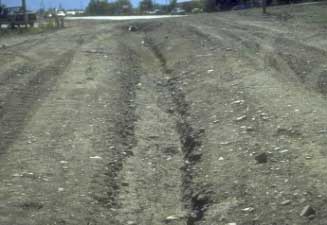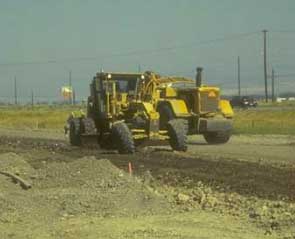Bolton on Landfill Management: Grader techniques: ditch construction & maintenance
By Neal Bolton, principal, Blue Ridge Services
Contents
Building new ditches
Cleaning existing ditches
With their ability to tilt, rotate and side-shift the moldboard, motor graders are well suited for constructing and maintaining ditches.
Of course they are limited in regard to the size of ditch they can create without help from other machines. Large ditches may have to be roughed out with a scraper or excavator before a grader comes in to do the finish trimming. But for small ditches, the grader can do it all.
Building new ditches
The most common type of ditch is the "Vee" ditch, so named because its cross-section looks like a V. The depth and sideslope will vary depending on the amount of flow the ditch must carry and the type of soil. A typical Vee ditch might be 1½ feet deep and have a 2:1 sideslope.

To construct this type of ditch, the grader will have to make several passes. The first few passes are intended to muck out as much soil as possible, drifting material to the right and left. For the first couple of passes, the grader should straddle the ditch with the blade (moldboard) angled steeply back. It's the same type of motion one might use to scrape paint off of glass with a putty knife or razor blade. Adjust the angle and the depth to where the grader is most productive. Again, the trick is to keep the working part of the blade directly under the center of the machine.

As the ditch begins to take shape, you'll want to reduce the angle on the blade to match the sideslope of the ditch (i.e., 2:1, etc.). Finally, once the ditch is shaped, the blade is placed into a more traditional "grading" position in order to drift the excess soil away from the ditch. In some cases, it may be necessary to pick up all or part of the soil with a loader or paddlewheel scraper, rather than spread the soil across a surfaced road. If this type of equipment isn't available, it may be best to drift all of the excess soil to the outside (away from the road) where it can be spread and scattered. In either case, planning ahead is important. (Back to top)
Cleaning existing ditches
When it comes to cleaning small, roadside ditches, a motor grader can't be beat. Some of the same rules that apply to building ditches also apply to cleaning them.
First, determine why the ditch is being cleaned. Is it overgrown with weeds, filled with sediment …or both? Understanding the problem is elementary in finding the best solution.
If the ditch is overgrown with weeds, very little material will be generated as a result of the ditch cleaning. If done properly, the weeds may simply be drifted (i.e., peeled) out of the ditch. They can be scattered and will dry up and disappear in a few days or weeks. In this situation, it's best to skim the blade across the surface, removing the weeds, but leaving the soil (and the roots) undisturbed. This will help keep the ditch bank stabilized. Remember, those roots are an important part of erosion prevention.
Note: In some cases, it may be best to remove weeds with a weed-eater or mower. This is certainly true if the soil is erosive or if it takes a long time to establish good vegetation.
If the ditch has (completely or partially) filled with sediment, the grader will have to remove it. Depending on how much sediment there is, ditch cleaning can almost be like constructing a new ditch. In either case, the first thought should be: "how much material must be removed?" The second is: "where will it go?" Remember, on a new road/ditch, is may be okay to drift excess soil across the roadbed. However, doing that on an existing gravel road will cause problems with dust and mud …and could even ruin the road.
If there is a lot of sediment to remove, one option is to drift it to the outside (away from the road) where it can be scattered and lost. If this isn't possible (e.g., there's too much sediment, there isn't room, etc.), it may be drifted out of the ditch and left (as a berm) along the shoulder of the road. Here it could be picked up with a loader or scraper and hauled away.
One way to learn more about the use of motor graders for building and cleaning ditches is to talk with the local (county) road superintendent. In most counties, there are miles and miles of rural roads (and roadside ditches) that must be continually cleaned. In many cases, this guy has forgotten more about graders and ditches than many of us ever know. If you're really serious, consider spending an afternoon driving around with the road superintendent as he checks on his crew. This would give you a great opportunity to pick up some tips and tricks. (Back to top)
About the author: Neal Bolton, a registered engineer, author of "The Handbook of Landfill Operations," and principal of Blue Ridge Services, provides operational consulting for landfills in the U.S. and abroad. He can be reached at blueridge@blueridgeservices.com. (Back)
